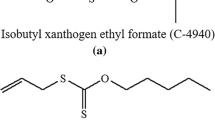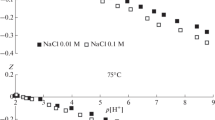Abstract
Characteristics and properties of complexes of a smectite (hectorite) with 1,10-phenanthroline (phen) chelates with iron or copper were determined by a variety of physical and chemical measurements. The complex ions showed high selectivity for the hectorite surface. Basal spacings of 17.4 Å were produced by Fe(II) or Cu(II) analogues of M(phen) 2+3 hectorite. Adsorption of gases and vapors by the M(phen) 2+3 hectorite complex revealed large surface areas and reflected intrinsic characteristics of the complex ions. Lower surface areas were found for copper phen hectorite than iron phen hectorite probably because of the loss of a ligand from the Cu(II) ion. ESR spectra confirmed that appreciable Cu(II) existed as the bis-phen complex under certain conditions. An increase in the oxidation potential of the Fe(phen) 2+3 -Fe(phen) 3+3 couple above that in pure solvent was noted when these complexes were supported by the mineral surface.
Similar content being viewed by others
References
Adamson, A. W. (1967) Physical Chemistry of Surfaces, pp. 585–589: Interscience, New York.
Allen, H. C., Kokoszka, G. F. and Inskeep, R. G. (1964) The electron paramagnetic resonance spectrum of some tris-complexes of Cu(II): J. Am. Chem. Soc. 86, 1023–1025.
Berkheiser, V. and Mortland, M. M. (1975) Variability in exchange ion position in smectite: dependence on interlayer solvent: Clays & Clay Minerals 23, 404–410.
Blau, F. (1898) Uber neue organische metallverbindungen: Monatsh. 19, 647–689.
Bower, C. A. (1962) Adsorption of o-phenanthroline by clay minerals and soils: Soil Sci. 93, 192–195.
Burchett, S. and Meloan, C. E. (1972) Infrared studies of water bound to some extracted phenanthroline and phenanthroline chelates: J. Inorg. Nucl. Chem. 14, 1207–1213.
Clementz, D. M. and Mortland, M. M. (1974) Properties of reduced charge montmorillonite: tetra-alkylammonium ion exchange forms: Clays & Clay Minerals 22, 223–229.
Farmer, V. C. and Russell, J. D. (1967) Infrared absorption spectrometry in clay studies: Clays & Clay Minerals 15, 121–142.
Gast, R. G. and Mortland, M. M. (1971) Self-diffusion of alkylammonium ions in montmorillonite: J. Colloid Interface Sci. 37, 80–92.
Greenland, D. J. and Quirk, J. P. (1962) Adsorption of 1-n-alkyl pyridinium bromides by montmorillonite: Clays & Clay Minerals 9, 484–499.
Hall, J. R., Marchant, N. K. and Plowman, R. A. (1963) Coordination compounds of substituted, 1,10-phenanthrolines and related dipyridyls: Aust. J. Chem. 16, 34–41.
Hathaway, B. J., Hodgson, P. G. and Power, P. C. (1974) Single-crystal electronic and electron spin resonance spectra of three tris-chelate copper(II) complexes: Inorg. Chem. 13, 2009–2013.
Hume, D. N. and Kolthoff, I. M. (1943) A revision of the oxidation potentials of the orthophenanthroline- and dipyridyl-ferrous complexes: J. Am. Chem. Soc. 65, 1895–1897.
Inskeep, R. G. (1962) Infrared spectra of metal complexes below 600cm−1: the spectra of the tris complexes of 1,10-phenanthroline and 2,2′-bipyridine with the transition metals iron(II) through zino(II): J. Inorg. Nucl. Chem. 24, 763–776.
James, B. R. and Williams, R. J. P. (1961) The oxidation-reduction potentials of some copper complexes: J. Chem. Soc. 2007–2019.
Jensen, A., Basolo, F. and Neumann, H. M. (1958) Mechanism of racemization of complex ions. IV. Effect of added large ions upon the rates of dissociation and racemization of tris-(1,10-phenanthroline)-iron(II) ion: J. Am. Chem. Soc. 80, 2354–2358.
Lagaly, G. and Weiss, A. (1975) The layer charge of smectite layer silicates: In Proc. International Clay Conf. (1975) (Edited by S. W. Bailey), pp. 157–172. Applied Publishing Ltd., Wilmette, IL.
Lawrie, D. C. (1961) A rapid method for the determination of approximate surface areas of clays: Soil Sci. 92, 188–191.
Mortland, M. M. and Berkheiser, V. E. (1976) Triethylenediamine-clay complexes as matrices for adsorption and catalytic reactions: Clays & Clay Minerals 24, 60–63.
Schilt, A. A. (1969) Analytical Applications of 1,10-phenanthroline and Related Compounds: Pergamon Press, Oxford.
Schilt, A. A. and Taylor, R. C. (1959) Infrared spectra of 1,10-phenanthroline metal complexes in the rock salt region below 2000 cm−1: J. Inorg. Nucl. Chem. 9, 211–221.
Author information
Authors and Affiliations
Additional information
Journal Article No. 7817. Michigan Agricultural Experiment Station. Work partially supported by National Science Foundation Grant No. MP S74-18201.
Rights and permissions
About this article
Cite this article
Berkheiser, V.E., Mortland, M.M. Hectorite Complexes with Cu(II) and Fe(II)-1,10-Phenanthroline Chelates. Clays Clay Miner. 25, 105–112 (1977). https://doi.org/10.1346/CCMN.1977.0250206
Received:
Accepted:
Published:
Issue Date:
DOI: https://doi.org/10.1346/CCMN.1977.0250206




